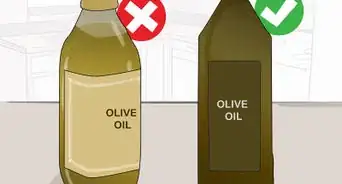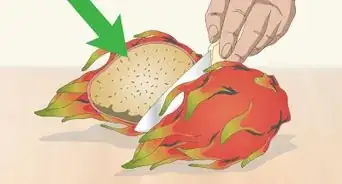This article was co-authored by Abyssinia Campbell. Abyssinia Campbell is an Executive Chef and the Owner of Chef Abyssinia, Personal Chef and Catering. With over ten years of experience, she specializes in catering, event planning, menu development, meal planning, and food business operations. When it comes to cooking, Chef Abyssinia enjoys using fruits, vegetables, healthy food alternatives, and local farm-fresh ingredients. She holds a BASc in Culinary Arts and Food Service Management from Johnson and Wales University.
wikiHow marks an article as reader-approved once it receives enough positive feedback. In this case, several readers have written to tell us that this article was helpful to them, earning it our reader-approved status.
This article has been viewed 132,551 times.
Properly stored, cooking oil can last for a long time. However, incorrectly stored oil can quickly turn rancid, even before its expiration date. This article will show you how to store your cooking oil, including covering which containers to use, where to keep it, and for how long. It will also explain how to tell if your cooking oil has gone rancid.
Steps
Using the Right Container
-
1Keep the cap or lid on the oil bottle when you are not using it. One of the main causes of oil turning rancid is exposure to too much oxygen. When you are not using the oil, keep the cap or lid on the container.
-
2Store the oil in a dark-colored glass bottle with a tight-fitting cap. Even if the oil comes in a clear, glass bottle, consider transferring it to a blue or green one. Sunlight degrades the quality of oil, and a dark-colored bottle will help to keep that from happening. Use a funnel to help guide the oil into the new bottle without spillage.Advertisement
-
3Avoid using plastic bottles. Plastic tends to leach chemicals over time.[citation needed] When this happens, it will affect the overall taste of the oil.[citation needed] If your oil came in a plastic bottle, consider transferring it to a glass bottle or jar with a tight-fitting lid.
-
4Avoid keeping cooking oils in containers made from iron or copper. These metals create a chemical reaction when they come in contact with oil and make it unsafe to use.[2]
-
5Consider transferring some oil into a smaller container to make it easier to pour. Some oils come in a large bottle or tin. These are often heavy and difficult to move. You can make use of this oil easier by transferring a small amount of the oil into a dark-colored glass bottle (see above for suggestions).
Storing Cooking Oil Properly
-
1Be familiar with which types of oils can be stored at room temperature. The following types of oils can be kept at room temperature:[3]
- Ghee oil can last for several months.
- Palm oil can last for several months.
- Peanut oil (refined) will last for two years.
- Vegetable oil can last for a year or longer as long as it is tightly covered.
- Olive oil may be kept in the cupboard (at temperatures between 57°F and 70ºF (14°C and 21ºC) for up to 15 months.
-
2Store the oil in a cool, dark cupboard or pantry. Do not store it near or above the stove. The frequent temperature changes will cause the oil to deteriorate.
-
3Know which types of oils are best stored in the refrigerator. Some oils will spoil if they are not kept in a cold place. Refrigeration will cause most oils to turn cloudy and thick. Because of this, you will need to take the oil out one to two hours before you need it, and let it sit at room temperature, allowing the oil to return to its usual consistency. The following oils should be kept in the fridge:[3] [4]
- Avocado oil will last for 9 to 12 months.
- Corn oil will last up to 6 months.
- Mustard oil will last 5 to 6 months.
- Safflower oil will last for 6 months.
- Sesame oil will last for 6 months.
- Truffle oil will last for 6 months.
-
4Know which oils can be stored at both room temperature or in the fridge. Some oils can be kept either in the fridge or in the cupboard. However, in most cases, refrigeration will prolong the oil's shelf life. Note that refrigeration will cause some oils to turn thick and cloudy. If this happens, take the oil out of the fridge one to two hours before you need it, allowing it to return to its usual consistency. The one exception to this is coconut oil, which is solid at room temperature. The following oils can be kept either in the fridge or in a cool, dark cupboard:[3] [4]
- Canola oil can be stored in the cupboard for 4 to 6 months, or in the fridge for 9 months.
- Chili oil can be stored in the cupboard for 6 months. It will last longer in the fridge.
- Coconut oil can be stored in the cupboard for months. It can last longer in the fridge but is difficult to use quickly from the refrigerator.
- Grapeseed oil can be stored in the cupboard for 3 months (up to 70ºF/21ºC), or in the fridge for 6 months.
- Hazelnut oil can be stored in the cupboard for 3 months. It will last in the fridge for up to 6 months.
- Depending on the type, lard can be stored either in the cupboard or in the fridge. Read the label for proper storing techniques.
- Macadamia nut oil can be stored in the cupboard for up to two years. It can last even longer in the fridge.
- Palm kernel oil can be stored in the cupboard for up to a year. It can last longer in the fridge.
- Walnut oil can be stored in the cupboard for 3 months. It will last in the fridge for up to 6 months.
-
5Avoid storing oil where it can be damaged. Sunlight and frequent temperature changes can deteriorate oil and cause it to go rancid. Unfortunately, some of the most popular places to keep oil, such as windowsills and on the counter, are often the worst because the oil is subjected to too much sunlight and changes in temperature. Avoid keeping your oil in the places listed below, even if the oil can be kept at room temperature:[2] [5]
- Windowsills
- The back ledge of a stove
- In a cabinet above the stove
- Next to the stove or oven
- On the counter
- Next to the refrigerator (the external side of a fridge can get quite hot through a cupboard partition)
- Near cooking appliances such as kettles, waffle makers and toasters.
Discarding Old or Stale Oil
-
1Be aware that oil stays fresh for a short duration only. When shopping for oil, you may notice two different types: refined and unrefined. Refined oils have been processed, and usually have little taste or nutritional value. Unrefined oils tend to be more pure, and are packed with nutrients. The label on the bottle or jar will tell you whether the oil is refined or unrefined. Here is how long you can expect both types of oils to last:[3]
- Refined oils will usually last 6 to 12 months if stored in a cool, dark cupboard (or fridge, if necessary).
- Unrefined oils will usually for 3 to 6 months if stored in a cool, dark, cupboard. A refrigerator is the best place to keep these oils.
-
2Sniff the oil every few months. If it smells bad or has a slight odor of wine, the oil has gone rancid. Toss the oil out.[4]
-
3Pay attention to the taste. If the oil tastes metallic, a little bit like wine, or just plain bad, it has likely gone bad, turned rancid, or oxidized.[3]
-
4Take note of how the oil was stored before it went bad. This might help you to understand why it went bad. Once you've figured out the reason, avoid making the same mistake when storing the next bottle of oil. Here are some things to look for when dealing with rancid oil:
- Check the expiration date: If the oil has gone bad because you didn't use it in time, get a smaller bottle the next time you go shopping.
- Was it was stored in a plastic container?: Some types of plastic leach into the oil and cause it to taste bad.
- Was it stored in a metal container?: Some metals, such as copper an iron, are reactive. They create a chemical reaction when they come in contact with oil and give it a metallic taste. Oils should never be stored in such containers.
- Consider where it was stored: Some oils need to be kept in the fridge while others need to be kept in a cool, dark cabinet. Oils should be kept out of places that receive too much sunlight or are subjected to fluctuating temperatures.
- How was it stored?: Was the cap on the container whenever the oil was not in use? Oil can go bad if it oxidizes.
-
5Do not pour oil down the drain. This is especially important if the oil is usually solid at room temperature. It may seem like a quick and convenient way to get rid of used oil, but it will only result in a clogged drain. The best way to get rid of used oil is to pour it into a leak-proof container, such as a jar or zippered plastic bag, and then to throw the container into the trashcan.[16]
Community Q&A
-
QuestionCan oil be left in a jar with a lid on a hot stove?
 Community AnswerNo. Never leave a jar of oil on a hot stove (or any other item, for that matter). The heated glass could explode.
Community AnswerNo. Never leave a jar of oil on a hot stove (or any other item, for that matter). The heated glass could explode. -
QuestionCan I reuse deep-frying oil?
 Community AnswerOf course you can. But don't reuse it too many times.
Community AnswerOf course you can. But don't reuse it too many times. -
QuestionCan I store used oil in a plastic gas can?
 Community AnswerYes, as long as the gas can has been completely washed with soap.
Community AnswerYes, as long as the gas can has been completely washed with soap.
Warnings
- Do not leave the cap off the oil for long periods of time. Oxygen will cause oil to go bad.⧼thumbs_response⧽
- Do not store oil in places where it will get too much sunlight or temperature changes. As already discussed above, these include: windowsills, counters, stove ledges, and cupboards above the stove.⧼thumbs_response⧽
- Take care when adding herbs and garlic to bottles of oil. These items should be soaked in vinegar for 24 hours prior to addition to the oil to minimize the transfer of pathogens that can cause such problems as botulism.[citation needed] Homemade herbal or garlic oils should be refrigerated and used quickly.[citation needed] For homemade garlic oil, use within one week of making.[citation needed]⧼thumbs_response⧽
Things You'll Need
- Cool, dry cupboard or fridge
- Dark-colored glass bottle
- Cooking oil
References
- ↑ 1.01.11.2Serious Eats, Equipment: Why it's Worth Buying an Olive Oil Pourer
- ↑ 2.02.12.2The Kitchn, The Best Way to Store Olive Oil
- ↑ 3.03.13.23.33.4Recipe Tips, Oils and Fats Handling/Safety/Storage
- ↑ 4.04.14.2Still Tasty, How to Keep Oils Fresh
- ↑ 5.05.1Reader's Digest, How to Keep Oil Fresh
About This Article
To store cooking oil, make sure to keep the cap or lid on the bottle when not in use to lessen the exposure to oxygen, which can cause oil to turn rancid more quickly. Additionally, store the oil in a dark-colored glass bottle since sunlight degrades the quality of oil. If possible, you’ll also want to avoid using plastic bottles as they can leach chemicals over time. Although you can keep most of your oils in a cool, dark cupboard or pantry, make sure to refrigerate avocado, corn, mustard, safflower, sesame, and truffle oils. To learn how to dispose of old or rancid oil, keep reading!
































































